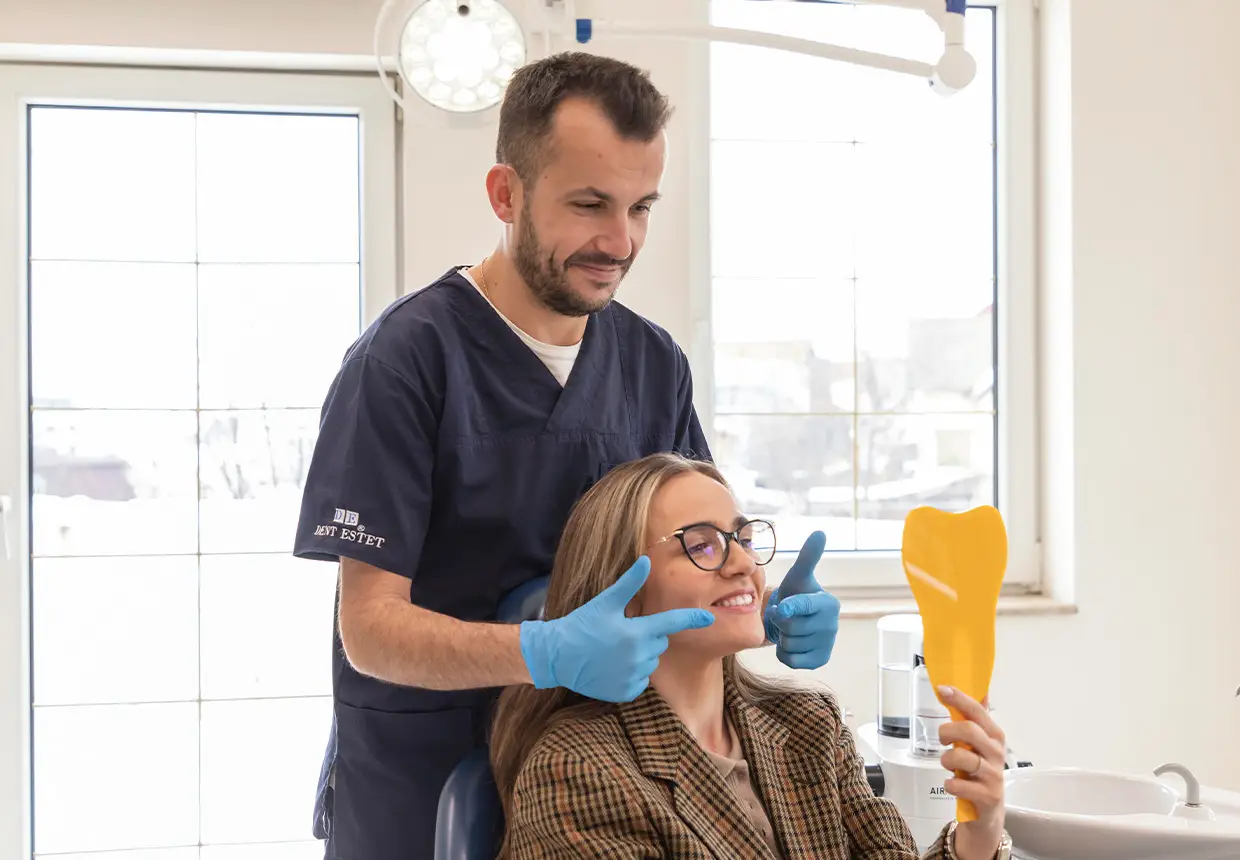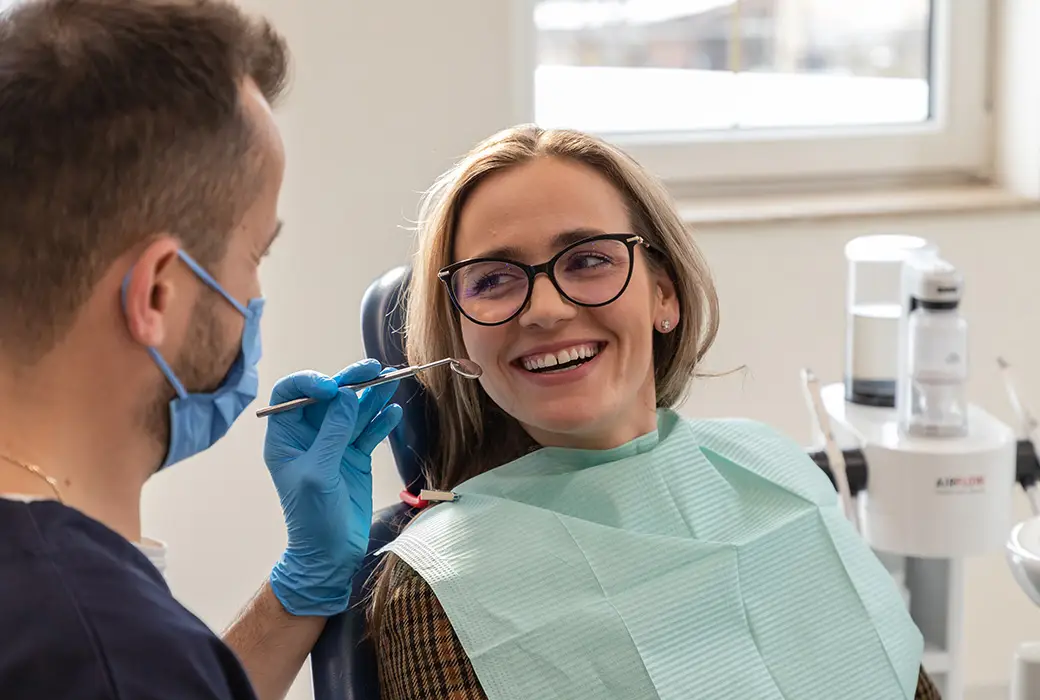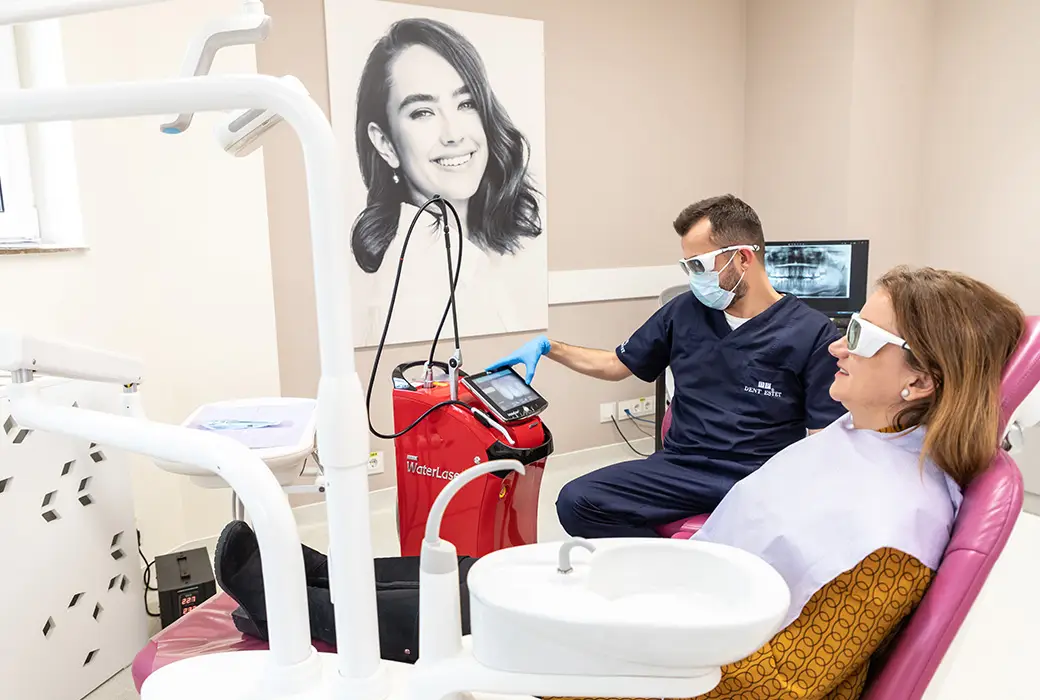
Gum recession – Causes and solutions
A beautiful and healthy smile is not just about bright, aligned teeth without cavities or other dental issues. It is also important to pay special attention to the gums, which play a crucial role in maintaining good oral health.
Healthy gums are light pink in color at the edge of the gingival tissue supporting the tooth root and darker on the mucosa not attached to the tooth. This protective tissue surrounds the bone around the entire circumference of the root, preventing the accumulation of food debris.
A common oral condition is gum recession. This occurs when the edge of the gingival tissue pulls away or recedes, exposing more of the tooth or the tooth root.
Many patients are unaware that they have gum recession, as the signs may develop over a long period. For this reason, regular visits to the dentist, at least twice a year, are crucial to identify any symptoms of gum recession.

Gum Recession – Signs
When the gums recede, gaps can form between the gum and the tooth, allowing bacteria to accumulate and leading to oral health issues.
To prevent such problems, we can watch for certain signs that indicate gum recession.
Long teeth
A sign of gum recession is the visible elongation of the teeth. When the gums recede for various reasons, the teeth appear longer than usual.
Exposed tooth roots
Exposed tooth roots are another symptom of gum recession, which requires a visit to the dentist, as this often leads to sensitivity and discomfort from contact with hot or cold foods.
The dentist is the only one who can determine if dental sensitivity or discomfort is a sign of periodontal disease or if it is due to aggressive brushing with a hard-bristled toothbrush.
Loose teeth
Loose teeth can be a symptom of gum recession. The causes of tooth mobility are numerous and require urgent intervention by the dentist to prevent tooth loss, which may only be replaceable with a dental implant.
Gum recession – causes
There are numerous causes of gum recession. The primary cause is periodontal disease (periodontitis), but there are also other conditions (dental malocclusions) or harmful habits (bruxism) that can lead to gum recession.

Periodontal disease, the main cause of gum recession
Periodontitis represents inflammation of the tissues supporting the teeth (periodontal tissue), caused by bacterial deposits, and can affect the gums, tooth cementum, alveolar bone, and ligaments.
The causative factor of periodontitis, like gingivitis, is the bacteria in plaque, formed in the absence of regular and proper oral hygiene. Bacteria in plaque lead to the destruction of the supporting ligaments and gum recession.
Since the initial stage of periodontal disease, gingivitis, is often painless, symptoms such as bleeding or inflamed gums may go unnoticed.
If left untreated, periodontitis can lead to premature tooth loss. In fact, periodontal diseases are the leading cause of tooth loss globally.
Dental malocclusions
Problems with tooth alignment (crooked, crowded teeth, or forms of dental malocclusion) can also cause gum recession. If a tooth is not aligned properly in the dental arch, it will grow into the inside or outside of the bony socket, resulting in partial exposure of the tooth root.
The result of this misalignment will be a thin gum or even partial gum loss in the area of the misaligned tooth.
The orthodontist is the specialist who can identify any form of dental malocclusion, and, together with specialists in periodontology and endodontics, can help address the causes leading to gum recession.
Aggressive tooth brushing
Additionally, aggressive tooth brushing can damage the gingival tissue, causing gum recession. In this regard, specialists at the DENT ESTET clinic can provide advice on proper tooth cleaning procedures, avoiding actions that remove plaque but also harm the gums.
The dentist can also recommend the best choice for a toothbrush and toothpaste, ensuring that they are not abrasive.
Poor oral hygiene
Plaque rapidly transforms into tartar when oral hygiene is not performed regularly and when dental floss and mouth rinses are not used. Tartar can push the edge of the gingival tissue, leaving the root exposed.
Bruxism
Bruxism, or teeth grinding, is another factor causing gum recession, as the pressure exerted by grinding can detach the edge of the gingival tissue.
Excessive smoking and dental trauma can also be causes of gum recession. Studies show that smokers are seven times more likely to develop a form of periodontal disease, which, as we have seen, is the primary cause of gum recession.
Treatment methods for gum recession
A mild case of gum recession can be treated with a deep cleaning performed by the dentist in the office.
Professional cleaning includes ultrasonic scaling, airflow, and professional brushing. At DENT ESTET clinics, Guided Biofilm Therapy is a "gold standard" procedure in dental prophylaxis, due to the benefits it offers.

GBT is a minimally invasive technology that completely eliminates pain and discomfort for the patient. This scaling technique can be successfully used for patients with periodontal conditions, those with prosthetic treatments (crowns, dental veneers), as well as those with braces or even implants.
During professional cleaning, plaque and tartar are removed, and the exposed root area is smoothed to make it more difficult for bacteria to adhere.

If professional cleaning is not sufficient to treat the condition, surgical intervention may be necessary to correct the receding gums.
It is important to note that gum recession can be prevented by:
- Proper oral hygiene at home (brushing teeth twice a day, in the morning and evening, for at least 2 minutes);
- Regular visits to the dentist;
- Professional cleaning sessions every six months or as recommended by the dentist;
- A balanced diet rich in nutrients from fruits and vegetables and low in sugars.
In conclusion, it is important to pay closer attention to symptoms occurring in the gum area, as healthy gums mean healthy teeth.



